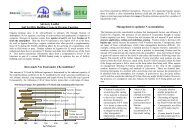Green Manures booklet - Institute of Organic Training and Advice
Green Manures booklet - Institute of Organic Training and Advice
Green Manures booklet - Institute of Organic Training and Advice
You also want an ePaper? Increase the reach of your titles
YUMPU automatically turns print PDFs into web optimized ePapers that Google loves.
An alternative is to save seed from current crop though in practice it is the exception rather than the rule. Much<br />
will depend on having the correct equipment on the farm <strong>and</strong> this will include cleaning <strong>and</strong> drying equipment as<br />
well as harvesting machinery. The other problem is that the crop will <strong>of</strong>ten need to be left in place for longer<br />
than normal to allow seed to set <strong>and</strong> mature.<br />
3.5. Mowing<br />
Most short-term green manures are grown to generate bulk <strong>and</strong> this is turned in at the end <strong>of</strong> the growing period,<br />
ideally before the crop has set seed. Longer-term green manures need active management if they are to generate<br />
the required benefits. In stockless systems this is achieved by periodic mowing in the so-called ‘cut <strong>and</strong> mulch’<br />
approach. The frequency <strong>of</strong> mowing will depend on the performance <strong>of</strong> the crop but as a general rule the crop is<br />
mown when it reaches about 45cm; any higher than this <strong>and</strong> the volume <strong>of</strong> cut material is likely to cause<br />
problems with smothering.<br />
Unless there is a severe weed problem the cut should take the crop height down to no lower than ankle height<br />
(10-15cm). This is to ensure that re-growth is rapid <strong>and</strong> is particularly important for non-grass crops where new<br />
growth <strong>of</strong>ten arises from aerial buds. To avoid swathes <strong>of</strong> plant material that can smother new growth a rotary or<br />
flail topper should be used to mince up the cut material <strong>and</strong> distribute it evenly across the sward.<br />
Some farmers may wish to remove the cut material to use as forage or graze their fertility building leys. This will<br />
obviously provide some cash return. There is evidence (Goodlass et al, 2006) that removal <strong>of</strong> the herbage will<br />
stimulate nitrogen fixation (because less nitrogen is available though fixation) <strong>and</strong> it may be possible to apply<br />
the mowings to a cash crop elsewhere, or to compost them for use later. However, with this approach there is a<br />
danger <strong>of</strong> depleting nutrients such as potassium to such an extent that regrowth may be inhibited.<br />
3.6. Incorporation techniques<br />
Effective incorporation <strong>of</strong> the green manure crop is as important a job as the growing <strong>of</strong> the crop. Breakdown <strong>of</strong><br />
the green material should happen quickly <strong>and</strong> this will depend on good mixing <strong>and</strong> adequate aeration <strong>of</strong> the soil.<br />
It is also important that the green manure has not become too mature <strong>and</strong> woody.<br />
The top growth should ideally be wilted before incorporation. If there is a lot <strong>of</strong> bulk a topper should be used to<br />
chop the growth, which is then wilted for up to 7 days before incorporation. An alternative approach uses disc<br />
harrows or a shallow rotavator to chop the green material into the soil surface. This material is then wilted in situ<br />
for 4-5 days before a further pass is made to finish the job.<br />
The relative merits <strong>of</strong> different incorporation machinery are listed in Table 3. The final choice may depend on<br />
the following crop eg the material must be well chopped up if there is to be a subsequent destoning operation<br />
before a root crop like potatoes are grown. Ploughing can be very effective – it should bury all the material <strong>and</strong><br />
leave clean furrows for working down to a seedbed. Care should be taken with heavy soils not to bury the<br />
material too deeply as further decomposition could be slowed down or prevented. The use <strong>of</strong> powered<br />
implements can be more effective in mixing but they are more expensive in terms <strong>of</strong> their power requirements<br />
The use <strong>of</strong> green manures<br />
16




